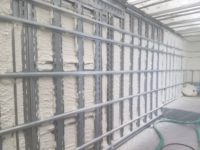The use of spray polyurethane foam in insulation applications continues to surge. As a high-performance material for the envelope, SPF provides superb energy efficiency, reducing heating and cooling demands up to 40 percent, while delivering the notable energy savings over the life of the structure. Additionally, the spray-applied material is notable for its ability to enhance indoor comfort and air quality, maintaining uniform indoor temperatures and preventing a wide variety of air contaminants from entering the structure.
SPF acts as a single-source solution for air, thermal and moisture control, reducing the need to apply numerous products to the envelope to achieve the same results. It is lightweight, durable and may be applied to almost any substrate.
SPF Density Classes
SPF is offered in a range of densities to meet varying insulation needs. All density options fit within one of three main categories:
- Open cell, or low-density foams consisting of 0.5 – 1.4-pound density per cubic foot with an open cell structure;
- Closed-cell, or medium density foams of 1.5 – 2.3-pound density per cubic foot with a closed-cell structure containing an insulating gas; and
- Roofing, or high density closed-cell foams of 2.5 – 3.5-pound density per cubic foot.
All three density varieties of Spray Polyurethane Foam act as insulators. However, the two types utilized to insulate the walls and ceilings in the envelope are open cell and closed cell SPF. Each offers a differing set of performance characteristics and benefits, influencing which is best suited for varying types of new construction and retrofit projects. Following are two case studies – each recognized by the Sprayfoam 2017 Convention & Expo’s Industry Excellence Awards program as stand-out projects - highlighting the reasons why each type of SPF insulation is beneficial in certain types of construction.
The Monsey Home: Open Cell SPF for Performance, Speed and Yield
In Monsey, N.Y., a community about 30 miles from Manhattan, a wealthy resident had commissioned a large, three-story home. Plans for the 3,325-square-foot residence called for it to be constructed with 2x6 wood studs, as well as for it to be insulated with Spray Polyurethane Foam because of the energy efficiency and indoor comfort achieved with the material.
The Monsey home was sprayed with a low density, or open cell, spray foam. The insulation was applied to the exterior envelope walls, as well as to the roof line. The foam provided a tight air seal for the structure, helping to adequately control ventilation rates, indoor temperatures, and humidity.
Airseal Insulations, a Brooklyn-based insulation contractor, completed the job noting that open cell SPF was selected specifically for both its performance characteristics and cost benefits.
“Not only did we select open cell SPF but we went with an ultra-low density 0.4-pound spray foam from SWD Urethane for this house,” says Ari Guttman, owner and manager with Airseal Insulations.
Another typical open cell spray foam density is 0.5-pound. “An ultra-low density 0.4-pound foam provides even greater yield and lift than you can get with a 0.5-pound option,” adds Guttman. “The lift allowed us to spray the insulation at a distance up to 15 feet from the surface, which proved beneficial as we were able to eliminate scaffolding and ladder requirements. Additionally, because we were able to spray 10 inches of thickness in one pass, this density of SPF allowed us to finish the installation faster, reducing overall costs to both us and the owner of the property.”
Key Open Cell Specification Considerations
Open cell SPF offers excellent thermal insulation and air sealing capabilities and is ideal for filling interior walls and ceilings where there is no risk of water contact. Impermeable to air movement, it helps to reduce the escape of conditioned air, which, in turn, reduces energy demands and operating costs.
Some additional performance factors to consider when considering open cell SPF for a project include:
- Because of its density, open cell SPF will offer a lower R-value, or resistance to heat flow, than its closed cell counterparts per installed inch thickness.
- Open cell SPF is vapor permeable, absorbing and releasing moisture vapor more freely than closed cell foams. This characteristic makes it ideal for interior applications as opposed to exterior applications where contact with water is possible.
- It is relatively soft to the touch with the material’s open cell structure providing flexibility to the foam.
- It performs better than higher density foams in the area of sound attenuation.
- Low density spray foam may also better accommodate the seasonal movement of some structures as compared to closed cell SPF.
- Open cell SPF typically boasts a lower installed cost than closed cell SPF.
The Sunset Fruits Facility
Sunset Fruits is one of the largest fresh fruit suppliers to both grocery stores and restaurants on the East Coast. Just recently, the company found it had outgrown its structure and after a lengthy search discovered a retired weigh-scale facility in Buffalo, N.Y., with the potential for a retrofit and expansion that would allow the company to successfully warehouse and distribute large quantities of fruit destined for numerous establishments within a 300-mile radius.
The existing structure, comprised of steel walls and structural steel, had absolutely zero insulation. This would be a primary focus of the renovation plan as the company needed to establish an environment conducive to the preservation of fruit, essentially creating 45 degree Fahrenheit coolers indoors.
United Thermal Systems, a contractor firm specializing in the application of SPF for roofing and insulation in the northeastern U.S. commercial and industrial marketplace, was brought in to insulate walls and ceilings throughout the facility. The team selected closed cell SPF for the project and 20,000 pounds of insulation was sprayed at a 3-inch thickness throughout the entire 24,760-square-foot facility.
“Utilizing closed-cell spray foam for the Sunset Fruits Facility was key for a number of reasons, not least of which is the material’s ability to act as both an air and vapor barrier,” says Larry Ash, vice president of United Thermal Systems. “The closed cell spray foam allows Sunset Fruits to control temperatures and moisture indoors.”
The insulation created a seal of the envelope including all air gaps and holes in metal side panel walls. “The spray foam’s ability to create a seal is monumental in a food facility of this type as it keeps indoor temperatures stable while preventing the formation of harmful mold and fungus.”
One caveat of this renovation was that the spray foam needed to be installed during wintertime with temperatures averaging 30 degrees Fahrenheit. For this reason, United Thermal Systems selected a specially blended closed cell variety that would still create an acceptable foam finish and provide high R-value, despite installation at temperatures below freezing.
“We needed to use a spray foam that would not only meet the facility performance requirements, but that we could install during the wintertime,” says Ash.
The rigidity of the closed cell foam also played a part in its specification. “Closed-cell SPF also has higher abuse potential meaning it won’t get disfigured if someone bumps into it,” says Ash. “This is important in a commercial structure where a lot of daily activity occurs.”
Key Closed Cell Specification Considerations
Closed cell SPF is ideal for continuous insulation applications and can be used in both interior and exterior applications where it can essentially replace commonly utilized rigid XPS and PIR foam boards. It is also ideally utilized in smaller spaces where a higher R-value is required or where severe moisture could be an issue.
Some additional performance factors to consider when considering closed cell SPF for a project include:
- Because of its density, closed cell SPF will provide a higher R-value, or resistance to heat flow, than its open cell counterparts per installed inch thickness.
- Installed at a thickness of 2 inches or greater, it will meet Class II vapor requirements for colder climates.
- It is classified by the FEMA as a flood-resistant material.
- It possesses higher tensile and bond strength than low density SPFs and provides additional structural strength to the building.
- Closed cell SPF options typically will have a slightly higher installed cost than open cell SPF installed to the same R-value.
- Some closed cell SPF formulations may be applied at temperatures as low as 5 degrees Fahrenheit, making them ideal for use in colder climate zones to ensure weather won’t impede installation.
Industry Certification More Important Than Ever
Whether specifying open cell or closed cell SPF insulation for your residential or commercial structure, it is important to note that both are intended for professional installation only to ensure best possible product and structure performance, as well as worker safety. With the growing use of SPF in the built environment, the verification of best practice adherence among installers, contractors and suppliers is ever important. As such, professional certifications and accreditations have become a critical designation for all involved in the installation of SPF. The Spray Polyurethane Foam Alliance offers a Professional Certification Program, giving all installers, field examiners, contractor companies, supplier companies and supplier representatives the opportunity to prove their knowledge and adherence to best practices.









Report Abusive Comment